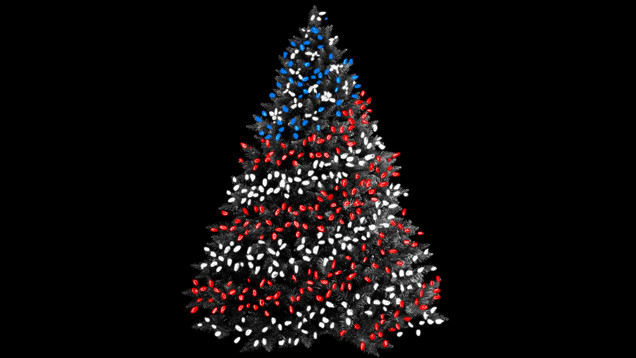
Christmas lights are a uniquely American tradition. That’s not just because the first electric Christmas lights appeared in America. The tradition embodies a certain American-ness, an ingenuity and hunger for innovation, that’s easily overlooked. America doesn’t just make things. America makes things spectacular.
The tradition of light and Christmas dates further back than America and even further back than Christianity. The holiday, of course, falls just after the winter solstice and the longest night of the year. All around the world lighting, there’s evidence of many ancient cultures fires in order to lure the sun back during this dark time of year. In different religions, the light takes on several different meanings: hope, rebirth, everlasting life. In American history, however, technology played a major role in transforming what was once believed to be a pagan ritual into a worldwide sensation driven by technology.
That little string of lights that you bought at the store and wrapped around your tree just to add a little twinkle to your home during the holidays? That’s as American as it gets. Of course, the glowing Christmas tree tradition started in Europe—but the Americans made it better.
Early 16th century: Martin Luther decorates the first Christmas tree
The original Martin Luther story is simple. One evening in, the leader of the Protestant Reformation took a walk in the woods to compose a sermon, saw the stars through some pine trees, and rushed home. In an attempt to recreate the beauty with his family, Luther set up a small evergreen tree inside the house and wired wax candles to the branches like so:
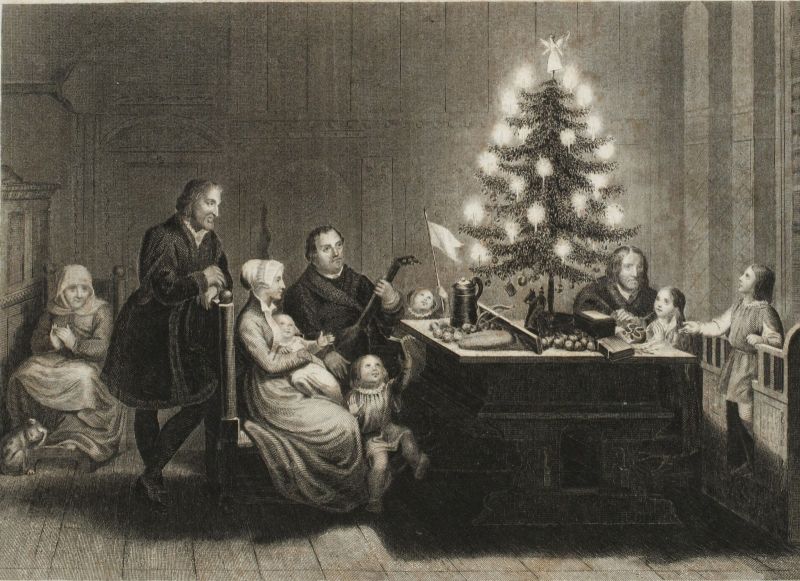
This is probably just a myth. Decorating homes with evergreen is a practice that goes back at least as far as the Romans and the Druids, but German Lutherans are credited with bringing the tradition of candle-lit Christmas trees to settlements in Pennsylvania as early as the 1747. At that time, New England Puritans viewed Christmas celebrations outside of church—namely Christmas trees—to be a form of “pagan mockery.” Indeed, pagans were into the evergreen thing, too. Attitudes changed once the royals got on board, though.
Sponsored
1846: Queen Victoria and Prince Albert make it fashionable
While German immigrants were being weird in Pennsylvania, Queen Victoria and her German-born husband Prince Albert made an unexpectedly powerful statement across the pond. In December 1848, a sketch of the royal family appeared gathered around a candle-lit Christmas tree in the Illustrated London News.
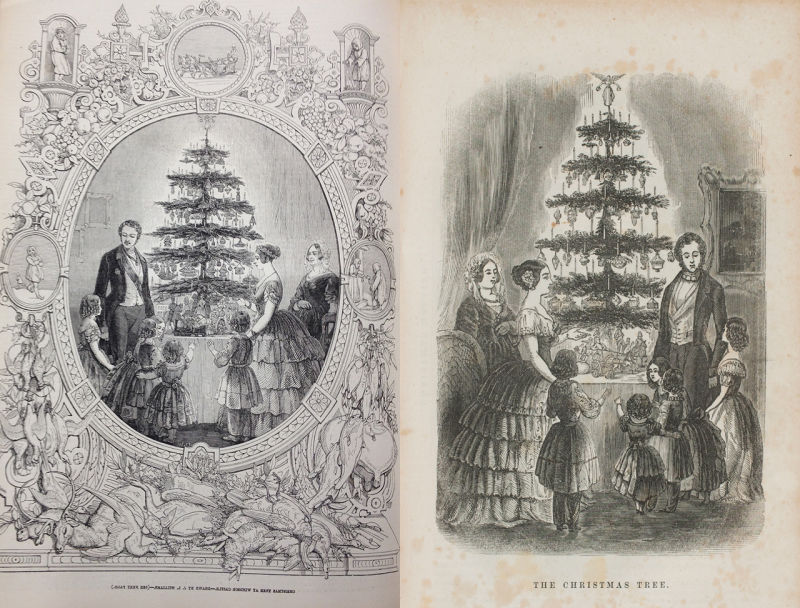
Two years later, Godey’s Lady’s Book republished the image with some slight variations, namely the removal of Victoria’s tiara and Albert’s mustache. This and other pictures of a family surrounding an evergreen tree decorated with candles sparked a Christmas craze that the United States embraced.
1879: Thomas Edison demonstrates his string of electric lights
This is where America takes charge. While many European scientists had been developing incandescent lightbulbs for years, Thomas Edison changed the game with his efficient, long-lasting carbon filament lamps.

The inventor strung the lights up at his laboratory in Menlo Park, New Jersey and invited on-lookers to come view them in late December. Although the official demonstration took place on New Years’ Eve in 1879, many people consider Edison’s innovation to be the world’s first string of Christmas lights.
1882: Edward H. Johnson shows off the first electric Christmas tree
While working as vice president of the Edison Electric Light Company, Edward H. Johnson decided to try replacing the traditional candles on a Christmas tree with electric lightbulbs. This was a great idea because the open candle flame tended to set dry trees on fire and burn people’s house down. Plus the lights would look spectacular.
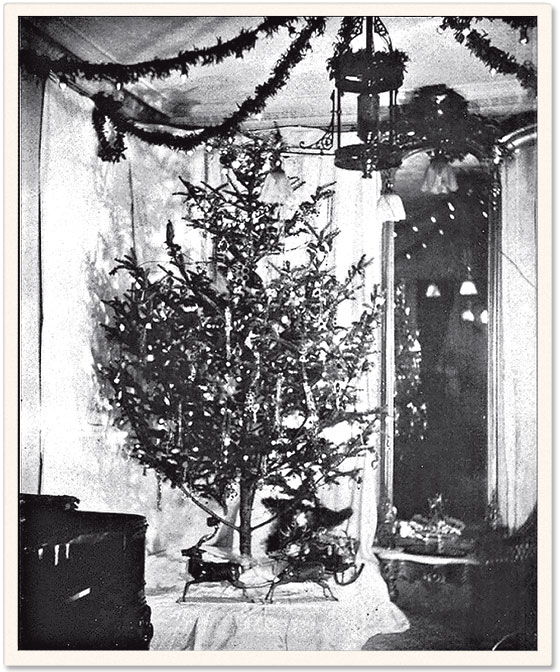
So in 1882, Johnson had 80 red, white, and blue walnut-sized bulbs specially made for his Christmas tree. He then strung around a Christmas tree which he placed on a rotating pine box at his home in Manhattan and invited reporters to come marvel at what he and Thomas hath wrought. “As the tree turned, the colors alternated, all the lamps going out and being relit at every revolution,” recalled a reporter from Detroit who witnessed the historical sight. “The result was a continuous twinkling of dancing colors, red, white, blue, white, red, blue—all evening. I need not tell you that the scintillating evergreen was a pretty sight—one can hardly imagine anything prettier.” The tree itself, however, was a little bit dinky.
So it turns out the tradition of hanging electric lights on Christmas trees was basically a publicity stunt to help Edison sell lightbulbs. Nevertheless, it was a dramatic innovation that turned a once frowned upon immigrant tradition into nationwide sensation. Of course, for a few years, it was a nationwide sensation only enjoyed by the very rich. Because early Christmas lights needed to be hard-wired into a lighting fixture, it cost the equivalent of hundreds of dollars to enjoy an electric glow during the holiday season.
1895: Grover Cleveland brings electric bulbs to the White House
Over a decade after Johnson’s first electric light Christmas tree, President Grover Cleveland requested that the White House Christmas tree be lit with a similar, albeit more elaborate display. The Wheeling Register said the tree as “very beautifully trimmed and decorated with tiny parti-colored electric lamps in place of the old time wax candles.” Whereas Johnson’s electric lights were meant to attract media attention, the elaborate decorations on the White House tree were probably meant to appeal to Cleveland’s three young daughters.

There’s some debate over the exact date of the above photo from the Cleveland White House, but it’s from around 1895.
1903: General Electric begins selling Christmas light kits
Though many Americans wanted a Christmas tree festooned with electric lights by the 20th-century, they remained reserved for the elite and the electricians who could string them up themselves. However, General Electric (of course) took the trend mainstream when it started selling prewired Christmas lighting set with Edison incandescent bulbs in 1903.

These multicolored lights came in wooden boxes with complete instructions on how to hang the lights and replace broken bulbs. From the wording, you can tell that the Americans who’d be stringing up the lights probably didn’t know what they were doing:
At one end of the lamp conductor will be found a screw attaching plug. This should be screwed into the nearest lamp socket in the room. The lamps are strung in series of eight on these festoons on loops of cord radiating from a junction box. This junction plug can be fastened to the decoration in an inconspicuous place and the festoons of cord with lamps can then be draped about the decoration and entwined as desired.
The General Electric kit sold for $12 for a three-festoon set—that would be about $325 today—kits could soon be found for as little as $1.50. Other companies like the American Eveready Company (now known just as Eveready) also sold socket-ready strings of lights for high prices. Consumers could also rent lights from local stores.
1919: GE introduces the flame-shaped bulb
From this point on, the American Christmas light industry was all about innovation. Strings of lights became brighter, longer-lasting, and cheaper after tungsten filament was introduced into the market around 1916. By 1919, GE strayed from the traditional globe-shaped bulbs and started selling cone- or flame-shaped bulbs sold under the same Mazda brand it used to sell regular-sized tungsten filament light bulbs.
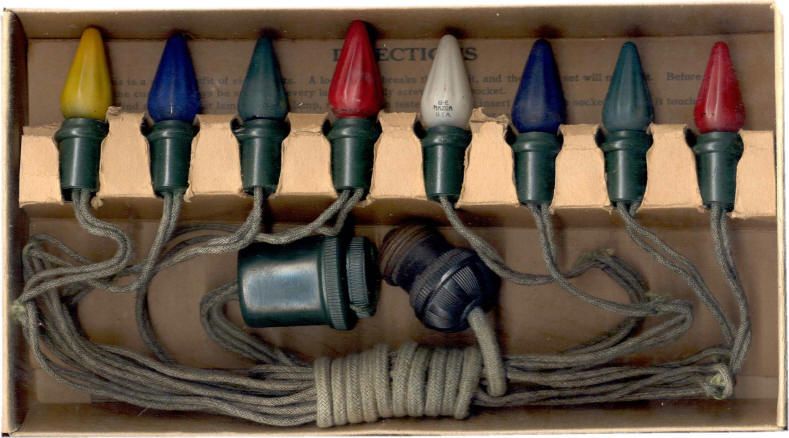
The bulbs would become a fixture in NOMA kits for years to come. GE discontinued the round globe bulbs altogether in 1922 and introduced the ribbed flame-shaped bulb in 1925.
1920s: Thermostat technology is used to create first blinking Christmas light
While it seems incremental, this was a big innovation for Christmas lights, one that had huge implications in American holiday culture for decades to come. In the 1920s, inventors filed a number of patents for blinking Christmas lights. Most relied on the same simple technology used in thermostats at the time.
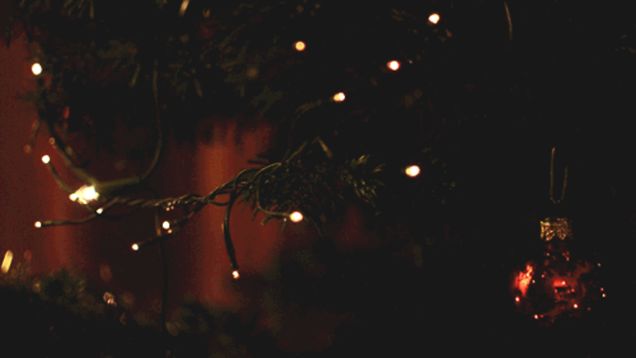
Basically, electricity would heat a small strip of metal that completed a circuit inside of the bulb. When the metal became hot, it would bend and break the circuit, turning the light off. As it cooled, it bent back and reconnected the circuit turning the light back on. This technology is still used in some blinking lightbulbs today.
1925: The NOMA Electric Company is born
As many trends in America go, first the rich tried Christmas lights, then the politicians followed. Finally, an enterprising teen figured out a way to make it work for everyone. So goes the legend of Albert Sadacca and the founding of the NOMA Electric Company anyways. Supposedly, after Christmas tree candles caused a fire in New York City in 1917, a 15-year-old Sadacca got the idea to repurpose the white novelty lights his parents sold for use in Christmas tree by adding colored lights to the strings. Again, this is a legend.

Regardless of the origin story, Sadacca and company went on to band together with about 15 other Christmas light manufacturers to form the National Outfit Manufacturer’s Association (NOMA) in 1925.
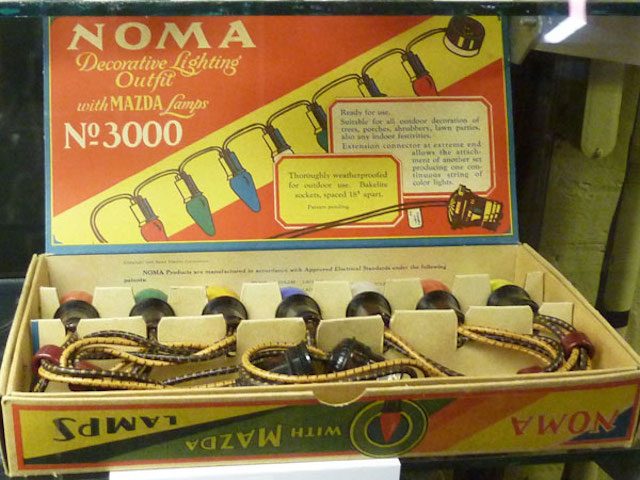
Until the 1960’s, NOMA more or less dominated the industry and introduced a number of important innovations to Christmas lights like all rubber cords and fused safety plugs. You might say that Christmas lights look they way they do today because of NOMA.
1946: NOMA brings bubble lights to the United States
While they first appeared in the England, bubble lights lights became a national craze in the United States, after NOMA introduced an American-patented version in 1946. (See how the pattern of America taking European traditions and making them awesome continues?)

The mechanics of the tacky decorations is relatively simple. An incandescent bulb encased in plastic heats a liquid with a low boiling point—usually methylene chloride—until it bubbles inside of a candle-shaped vial. Watch them bubble!
1950s-60s: Aluminum Christmas tree fad pits commercialization against tradition
If you know any baby boomers, they’ve probably pulled presents out from underneath an aluminum Christmas tree at some point in their life. Marketed as a permanent tree that never needed water, the aluminum Christmas tree became the shining example of how consumerism could ruin Christmas tradition.
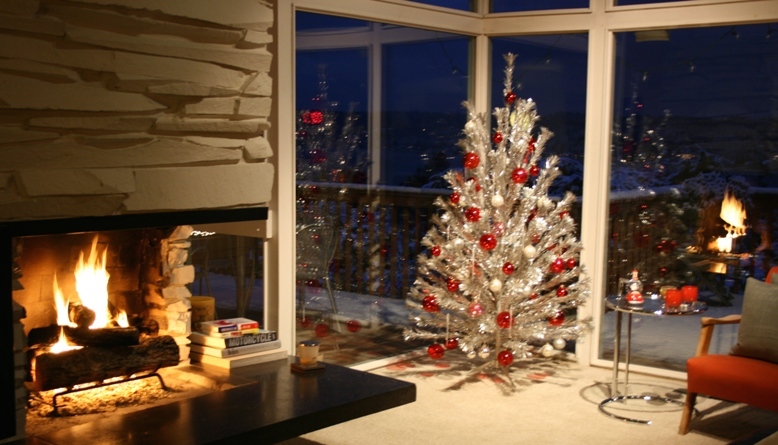
First introduced in the 1950s and reaching peak popularity in the early 1960s, these gleaming beacons of capitalism were perfect for the Space Age. A 1963 Sears Christmas Booksreads:
Whether you decorate with blue or red balls… or use the tree without ornaments — this exquisite tree is sure to be the talk of your neighborhood. High luster aluminum gives a dazzling brilliance. Shimmering silvery branches are swirled and tapered to a handsome realistic fullness. It’s really durable… needles are glued and mechanically locked on. Fireproof… you can use it year after year.
While the fireproof marketing message endures, the aluminum trees were obviously huge conductors so electric Christmas lights couldn’t be hung. Rotating likes like this were instead used to project light onto the chrome-colored tree. Inevitably, the Christmas lights industry took a nosedive, and in 1966, NOMA filed for bankruptcy. It was the largest Christmas tree lights company in the world at the time.
1966: GE blankets suburbia with foreign-made Merry Midget lights
This is when things get really nuts. With the American holiday light industry gutted, manufacturing moved overseas, and the lights got cheap. GE also combined a number of innovations and introduced the very familiar—and still available—Merry Midget light sets. These affordable kits were first manufactured in Japan and then in Taiwan.
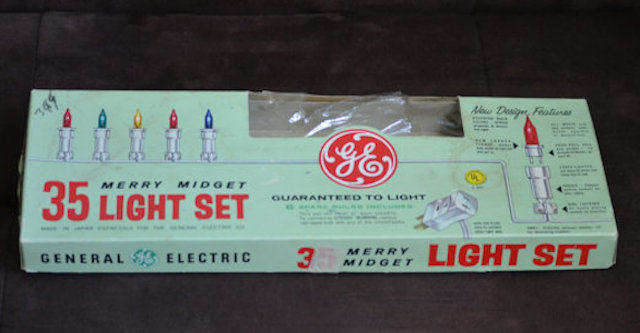
The Merry Midgets were the first of many icicle-shaped mini-lights to appear in stores, and the outdoor-friendly design took suburbia by storm. Before long, you couldn’t drive through a neighborhood in middle America during the holiday season without seeing a tract house trimmed with mini-lights.
1970s and 1980s: Utter chaos
Once Christmas lights were tough enough to go outside and cheap enough to be disposable, Americans went nuts. Little innovations like lights that fluctuated according to sound and flickering flame light that used semiconductors appeared in the 1970s. For the most part, though, the holiday season became a competition of who could blow the most money on the most ridiculous holiday decorations. The dad who built the biggest spectacle wins.
Of course, at this point in time, the trend had traveled around the world. America took the European tradition of hanging lights on trees and turned it into an opportunity of technological innovation (and profit).
1990s to today: America deals with the hangover
After so many decades of pumping electricity into tiny lights to make our Christmas trees pretty, Americans started to catch on to the potentially damaging effects of such consumption. The first fully programmable lighting system was patented in 1995, making it easier to control light displays and conserve energy.
The latest innovations have less to do with getting incandescent bulbs to do new things than with getting rid of them altogether. Suburban America is now hungry for long-lasting, energy-conserving LED lights. Meanwhile, they’re coming up with all kinds of creative ways to recycle those old incandescents. Because once we get good at inventing something, we get better at making it cheap and disposable. Eventually, we make something better and throw the old things away. But hey, in America, we even throw things away with pride these days.
GIF by Jim Cooke
